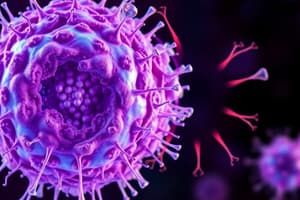Podcast
Questions and Answers
What is a key feature of eukaryotic cells that distinguishes them from prokaryotic cells?
What is a key feature of eukaryotic cells that distinguishes them from prokaryotic cells?
- Formation of genetic material in ribosomes
- Absence of internal membrane systems
- Lack of ability to synthesize proteins
- Presence of genetic material enclosed in a nucleus (correct)
Which organelles in eukaryotic cells share similarities with prokaryotic cells according to the text?
Which organelles in eukaryotic cells share similarities with prokaryotic cells according to the text?
- Endoplasmic Reticulum and Golgi Apparatus
- Lysosomes and Peroxisomes
- Mitochondria and Chloroplasts (correct)
- Nucleus and Ribosomes
What is a likely function of the endoplasmic reticulum in eukaryotic cells?
What is a likely function of the endoplasmic reticulum in eukaryotic cells?
- Regulation of cell shape
- Generation of energy through photosynthesis
- Facilitating synthesis and transport of proteins (correct)
- Storage of genetic material
How did the internal membrane systems contribute to the evolution of eukaryotic cell functions?
How did the internal membrane systems contribute to the evolution of eukaryotic cell functions?
Which statement supports the idea that mitochondria and chloroplasts may have originated from bacteria?
Which statement supports the idea that mitochondria and chloroplasts may have originated from bacteria?
Why did the development of internal membrane systems contribute to increased efficiency in eukaryotic cells?
Why did the development of internal membrane systems contribute to increased efficiency in eukaryotic cells?
Which type of bacteria is known for its long, thin, and filament-like shape?
Which type of bacteria is known for its long, thin, and filament-like shape?
What is a defining characteristic of spirillum bacteria?
What is a defining characteristic of spirillum bacteria?
Which bacterium is responsible for cholera and has a curved or comma-shaped structure?
Which bacterium is responsible for cholera and has a curved or comma-shaped structure?
In eukaryotic cells, where are the chromosomes contained?
In eukaryotic cells, where are the chromosomes contained?
Which organelle is responsible for surrounding the linear genetic material (DNA) in eukaryotic cells?
Which organelle is responsible for surrounding the linear genetic material (DNA) in eukaryotic cells?
What is a key difference in size between eukaryotic cells and prokaryotic cells?
What is a key difference in size between eukaryotic cells and prokaryotic cells?
Which of the following statements accurately describes prokaryotic cells?
Which of the following statements accurately describes prokaryotic cells?
Which type of cells possess a true nucleus enclosed within a nuclear membrane?
Which type of cells possess a true nucleus enclosed within a nuclear membrane?
What is a characteristic feature of prokaryotic cells in terms of internal structure?
What is a characteristic feature of prokaryotic cells in terms of internal structure?
Which of the following is a known characteristic of eukaryotic cells?
Which of the following is a known characteristic of eukaryotic cells?
In terms of size and complexity, how do prokaryotic cells generally compare to eukaryotic cells?
In terms of size and complexity, how do prokaryotic cells generally compare to eukaryotic cells?
Which type of cells are commonly found in organisms belonging to the domain Eukarya?
Which type of cells are commonly found in organisms belonging to the domain Eukarya?
Study Notes
Eukaryotic vs. Prokaryotic Cells
- Eukaryotic cells possess a true nucleus, distinguishing them from prokaryotic cells, which lack this feature.
- Eukaryotic organelles, such as mitochondria and chloroplasts, share structural and functional similarities with prokaryotic cells, suggesting a common evolutionary origin.
Endoplasmic Reticulum Function
- The endoplasmic reticulum (ER) in eukaryotic cells is likely involved in the synthesis of proteins and lipids, playing a crucial role in cellular function and metabolism.
Evolution of Eukaryotic Cells
- Internal membrane systems in eukaryotic cells contributed to the evolution of more complex cell functions by compartmentalizing biochemical processes, enhancing efficiency and specialization.
Origin of Mitochondria and Chloroplasts
- The endosymbiotic theory is supported by the presence of DNA within mitochondria and chloroplasts, similar to that found in bacteria, indicating their potential bacterial ancestry.
Efficiency in Eukaryotic Cells
- Development of internal membrane systems enabled eukaryotic cells to minimize competing metabolic processes, leading to improved efficiency and better regulation of cellular activities.
Bacterial Morphology
- Filamentous bacteria are characterized by their long, thin, and filament-like shape, often contributing to their unique ecological adaptations.
- Spirillum bacteria are recognized for their spiral shape, contributing to their movement in aquatic environments.
Pathogenic Bacteria
- Vibrio cholerae is the bacterium responsible for cholera, identifiable by its curved or comma-shaped structure.
Chromosomes in Eukaryotic Cells
- In eukaryotic cells, chromosomes are contained within the nucleus, which protects and regulates access to genetic material.
- The nuclear membrane surrounds linear genetic material (DNA), delineating it from the cytoplasm.
Size Comparison
- Eukaryotic cells are generally larger and more complex than prokaryotic cells, which tend to be smaller and simpler in structure.
Prokaryotic Cells Characteristics
- Prokaryotic cells lack a true nucleus and internal membrane-bound organelles, making their internal structure less complex compared to eukaryotic cells.
- Common characteristics include smaller size, simpler organization, and the presence of peptidoglycan in cell walls (in many but not all prokaryotes).
Eukaryotic Cell Characteristics
- Eukaryotic cells typically have membrane-bound organelles, including Golgi apparatus, lysosomes, and endoplasmic reticulum, facilitating various cellular processes.
Domain Eukarya
- Eukaryotic cells are commonly found in organisms belonging to the domain Eukarya, which includes animals, plants, fungi, and protists, showcasing diversity in form and function.
Studying That Suits You
Use AI to generate personalized quizzes and flashcards to suit your learning preferences.
Description
Test your knowledge on the differences between prokaryotic and eukaryotic cells. Learn about the characteristics and examples of each cell type.




